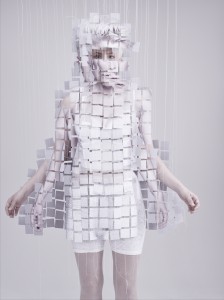In Melbourne, designing future bodies

[caption id="attachment_7214" align="aligncenter" width="620" caption="Lucy McRae in the TransNatural campaign."] A A film still from 'Morphe', a collaboration between Lucy McRae and Aesop.
A A film still from 'Morphe', a collaboration between Lucy McRae and Aesop.
MELBOURNE -- Imagine you could take a pill that lets you sweat perfume; have an electronic tattoo that could be augmented by touch; or wear a dress that blushes and shivers with your emotions. No, this isn’t the stuff of sci-fi dreams, it’s the far-future designs of Melbourne body architect Lucy McRae.
McRae imagines new ways to merge biology and technology into our own bodies. Her visualizations are fascinating and often unnerving possibilities of what our bodies might look like in the future.
 [/caption]A current TED Fellow, McRae regards the body as a blank canvas for her investigations, a core which she builds layers and concepts on top of. She is driven by an insatiable curiosity and desire to change the way we think about our bodies.
[/caption]A current TED Fellow, McRae regards the body as a blank canvas for her investigations, a core which she builds layers and concepts on top of. She is driven by an insatiable curiosity and desire to change the way we think about our bodies.
“As a body architect, I find ways of extending the body beyond its physical and biological edge, manipulating the natural silhouette with materials that are draped, injected or bathed over the skin," she explains.“The outcome can sometimes be surprisingly morbid, imperfect or grotesque, each time I’m never anticipating the final result.”
So what exactly is a body architect? McRae says she is the first and only 'body architect' in the world, and gave herself the title to convince HR at Philips FutureLab to hire her. And it worked.
This elusiveness of an understandable job title has allowed her to create a unique specialization based on her diverse background and training.
As a teenager McRae was an athlete, competing in 100-meter hurdle events at State level. She also trained in classical ballet from the age of four until the time she left high school.
“The more projects I complete, the more I understand the influence my ballet training has. I developed a conscious awareness and periphery of understanding people’s body movements and behavior,” she says.
McRae quit ballet because she knew a career in dance was going to be short lived. She went on to design school, and later worked in architecture firms, with a brief stint in the fashion industry.
Today she is based in Amsterdam, returning home to Melbourne on occasion to work on commissioned works. Within the Philips Design Probes team, she examines how technology could impact the human body in 15 to 20 years (known in the industry as 'far-future' design).
“Most projects are motivated by the relationship technology has with the human body, inventing and speculating ways of merging the two closer together,” she says.
She has explored this concept in a number of projects, including her low-fi, confronting experiments with friend and Dutch artist Bart Hess.The two work under the moniker LucyandBart.
McRae's commissioned works has also produced some curious results. The most well known is the liquid textile dress she made for Swedish pop star Robyn on the 'Indestructible' music video clip.

More recently, McRae unveiled the film Morphe -- a collaboration with the Melbourne skincare brand Aesop.
Morphe is set in a future laboratory in which a scientist administers an assortment of gels, liquids and other beauty treatments to a sleeping muse.
"My work is seeded from instinct. My process is primitive, driven and inspired by my immediate surroundings. I think Aesop has subliminal effects on people. I feel we are both creating alternate worlds which are sincere and unafraid," she says.
The film has obvious references to both Mary Shelley’s Frankenstein and Charles Perrault’s Sleeping Beauty. But McRae says that the inspiration for the narrative came from the nineteenth-century physicist and philosopher Hermann Ludwig Helmholtz and his observation on human perception, that "everything is an event on the skin."
She has also finished directing a film for an Australian art patron and restaurant owner which links food and the body in a macabre setting.
“In the film I create an alternative world where we see a lone woman meticulously concocting substances in a morgue-type laboratory. Reproducing 'life', she clones humans, mixes genders, and fuses man and woman, like a chef composes food."
"Each clone has slightly different sensory enhancements in taste or sight which she makes according to her mathematical matrix.”
“I use film as a way of experimenting and testing these ideas, creating alternative worlds where science, technology, architecture and fashion co-exist.
McRae also cites gene mutations as a source of inspiration. And she enthuses over the work of Professor Gregory Sporton, who has developed a vibrating suit used for training elite Olympic gymnasts.
“I like thinking about how this perfecting technology could affect fashion or dance. Imagine having people walking down the street performing obscured alien movements while wearing this vibrational suit,” she says.
It is this 'what if?' exploration of the crossover between technology and the body that continues to inform her work.
“The body is soaked in information and I find ways of harnessing that knowledge to innovate and evolve the body. My work blurs and disrupts the physical edges of the human silhouette and its effects on behaviour and communication."
Photos: Courtesy of Lucy McRae and Aesop.
This post was originally published on Smartplanet.com